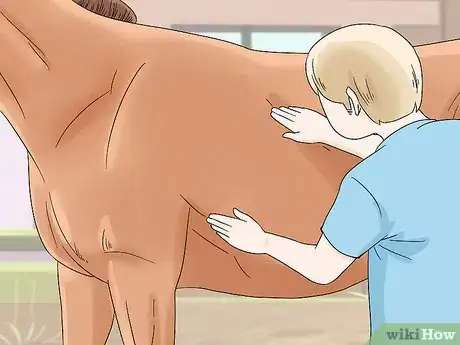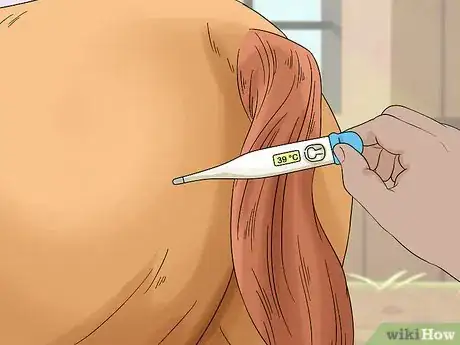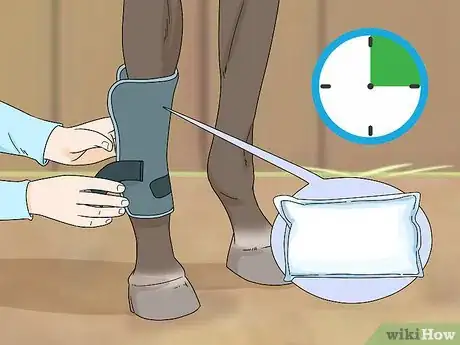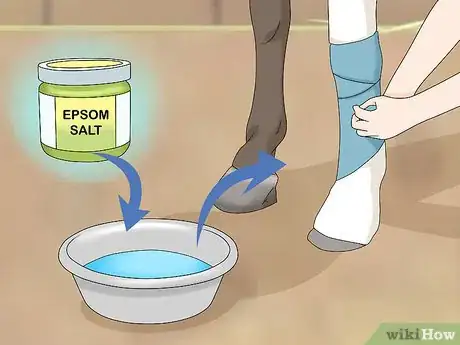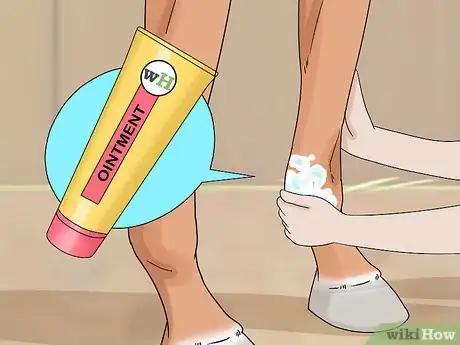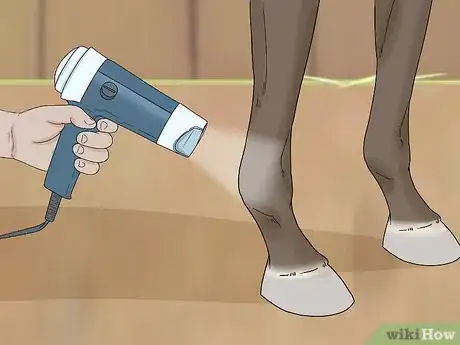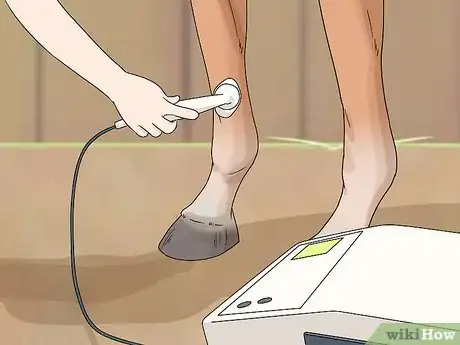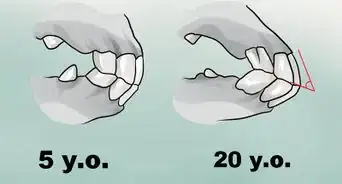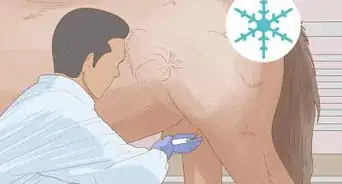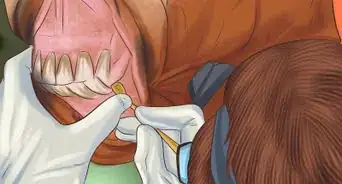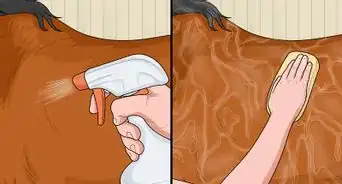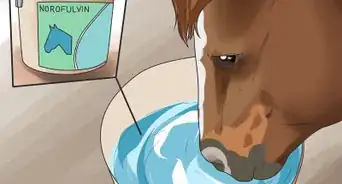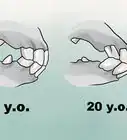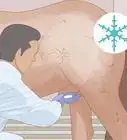This article was co-authored by Ryan Corrigan, LVT, VTS-EVN. Ryan Corrigan is a Licensed Veterinary Technician in California. She received her Bachelor of Science in Veterinary Technology from Purdue University in 2010. She is also a Member of the Academy of Equine Veterinary Nursing Technicians since 2011.
There are 9 references cited in this article, which can be found at the bottom of the page.
This article has been viewed 35,659 times.
Edema is a fluid-filled area under the skin, and a range of conditions can cause it. Generally, edema appears as a swollen, lumpy area on your horse's body. If you notice an abnormality on your horse, inspect the area and assess your horse's overall condition. Proper treatment depends on the underlying cause, so getting an accurate diagnosis from the vet is essential. Fortunately, edemas due to common issues such as allergies and minor injuries are fairly easy to manage. Other conditions, such as infections or lymph system issues, can be serious and require emergency care.
Steps
Administering First Aid
-
1Wash your hands before and after touching the edema. Scrub your hands with soap and hot water for at least 20 seconds. Wash up again after examining or caring for the edema.[1]
- Hand hygiene will help keep germs from spreading to and from the problem area.
-
2Clean and bandage any wounds if your horse sustained an injury. Flush an open wound with warm water, then rinse it with a saline or iodine solution. Cover it firmly with a clean elastic bandage until the vet can examine it.
- Don't apply any medicated ointment after cleaning the wound unless the vet advises.
Advertisement -
3Inspect the swollen area's consistency and size. Move the skin around gently to see if it passes over the swelling or if the lump moves with the skin. Check whether the area is soft, hard, or jelly-like in consistency. Press it with your fingertip and see if an imprint remains for a second or more.[2]
- Whether or not skin moves over the swollen area will help you and the vet determine its location.
- Softness is a sign that's it's an edema and is filled with liquid. Hardness indicates scar tissue or a tumorous growth, and a jelly-like consistency is usually a hematoma.
- The lump is most likely an edema if an imprint remains, as if you were pressing into a marshmallow. This is known as "pitting edema." If skin springs back immediately, the lump is most likely a hematoma or inflamed tissue.
-
4Take the horse's temperature, if possible. If you have a digital rectal thermometer and know how to use it, lubricate it and gently insert it into your horse's rectum. A normal temperature should be between 99 to 100.5 °F (37.2 to 38.1 °C). A temperature over 102 °F (39 °C) could indicate a serious infection.
-
5Call the vet and describe your horse's condition. Describe what the lump feels like, your horse's overall demeanor, and when the symptoms began. Tell the vet your horse's temperature (if you took it), if your horse sustained an injury, and any other relevant details. Ask if they should examine your horse, if the situation is an emergency, and if there's anything you need to do before they arrive.[3]
- Make sure to note any cuts or breaks in the skin, since these are typically where bacteria get in to cause cellulitis and edema.
- Since edema is a general medical term, use descriptive words such as “fluid-filled,” “warm to the touch,” and “weeping.” Describe details such as the lump's consistency, size, location, and whether an imprint remains after pressing it.[4]
- If they need to examine the horse, set up an outdoor extension plug. It'll come in handy if they need to perform an ultrasound.
Managing Common Causes
-
1Apply ice for 10 to 15 minutes every 3 to 4 hours, if the vet approves. When you initially call the vet, they might advise flushing the area with cold water or applying ice. Icing the area regularly for 48 hours can help relieve pain and inflammation.[5]
- Applying ice is recommended for edemas and other forms of swelling due to an injury or infection.[6]
- Consult the vet if your horse doesn't show signs of improvement within 1 to 2 days.
-
2Wrap the area with a clean Epsom salt bandage. If it is possible to wrap the area, do so using a clean bandage that has been soaked in warm water and a generous amount of Epsom salt. Keep the wrap in place for 20 minutes. After you remove the wrap, dry the area thoroughly.
- The Epsom salt helps draw out the excess fluid in the area.
-
3Clean the area and apply ointment for edemas caused by insect bites. Allergic reactions to bites are common and relatively easy to treat. Clean the area with a saline or iodine solution at least once a day, and remove any crusty or scaly deposits. Have the vet recommend a corticosteroid cream and apply it to the affected area as directed.
- If the vet advises, keep the area bandaged. Change the dressing and apply ointment at least once a day, or according to the vet's instructions.
- To prevent bug bites, use an insect repellent labeled for horses. Spray it on all areas of your horse's body 2 to 3 times a day.
-
4Manage CPL with routine skin care and exercise. Chronic progressive lymphedema (CPL) is a disease caused by lymph and circulatory system issues. Keep your horse clean and dry, especially its lower limbs, and blow-dry the lower limbs when they become wet. Ensure it gets daily exercise, which will help prevent fluid from building up in its lower limbs.
- If your horse is heavily feathered (or has thick hair around its feet), keep it trimmed short.
- Symptoms of CPL include skin infections, skin thickening, edema, and abscesses that primarily affect the lower limbs.
- CPL is a chronic disease and is common in heavily feathered horses. It's more serious than insect bites or minor injuries, but proper management can prevent it from becoming severe.
Treating Serious Underlying Conditions
-
1Have the vet take an ultrasound and culture. An ultrasound can help the vet gauge the scope of an injury or, for an abdominal edema, identify digestive tract issues. If they suspect an infection, they'll take a bacterial culture. Additionally, they might order blood work and test for problems with the heart, lymph nodes, liver, kidneys, and other organs.[7]
-
2Treat widespread infections with high-dose antibiotics. Serious infections that cause widespread edemas require strong antibiotics, which are administered intravenously (by IV). An infection can cause fluid and electrolyte loss, so an IV might also be necessary to prevent dehydration.[8]
- If the edema is related to a serious infection, your horse might need to stay at a clinic until its symptoms improve.
-
3Discuss abdominal edema treatment options with the vet. Fluid-filled areas of swelling around the stomach could be related to a digestive tract problem. A minor blockage or ulcer might require diuretic medication (which reduces fluid retention) and stool softener. Surgery might be necessary for more serious conditions.[9]
- Depending on the underlying digestive issue, the vet might recommend dietary changes. For example, your horse might need to temporarily switch from dry hay to a special pelleted diet.[10]
-
4Work with the vet to manage heart, lymph node, or circulatory issues. Your horse might need to take medication regularly if the vet finds heart or lymph node issues. Possible underlying issues, such as heart disease and cancer, might require ongoing specialist care.
- Unfortunately, chronic widespread edemas could be related to life-threatening conditions, such as congestive heart failure and aggressive cancer. If your horse is very sick, ask the vet how to make it comfortable. Losing a companion is difficult, but putting it to sleep might be best if it's suffering.
References
- ↑ https://equusmagazine.com/management/identify-horse-skin-problems-8173
- ↑ https://equusmagazine.com/management/identify-horse-skin-problems-8173
- ↑ https://www.bluecross.org.uk/pet-advice/basic-first-aid-horses
- ↑ https://equusmagazine.com/blog-equus/horse-health-words-of-the-week-edema-and-inflammation
- ↑ https://aaep.org/horsehealth/cold-therapy-ice-bandages
- ↑ https://equusmagazine.com/management/challenge-cellulitis-31376
- ↑ https://aaep.org/sites/default/files/Guidelines/PigeonFeverGuidelines52713.pdf
- ↑ http://www.merckvetmanual.com/generalized-conditions/clostridial-diseases/malignant-edema
- ↑ http://www.acvim.org/Portals/0/PDF/Animal%20Owner%20Fact%20Sheets/LAIM/Colitis%20in%20Adult%20Horses.pdf


